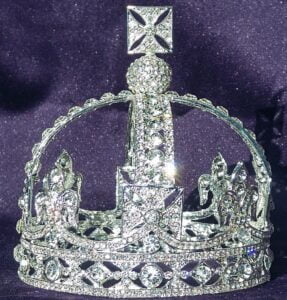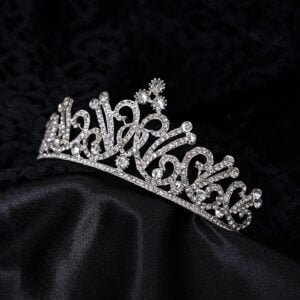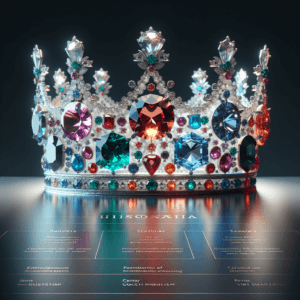What Gems Represent Royalty?
What Gems Represent Royalty? In the captivating article ‘What Gems Represent Royalty?’, you will explore the timeless connection between magnificent gemstones and the world of regality. Unravel the rich history, long-held traditions, and the symbolic significance of various jewels associated with kings, queens, and royal families worldwide. Stride forward, your highness, and discover the gemstones that truly embody royalty.

Historical Significance of Gems in Royalty
Gemstones have held a significant place in royalty throughout history. Their enduring allure stems from their rarity, luminous beauty, and the belief in their formidable powers. These qualities have made them indispensable elements in royal paraphernalia throughout the world.
Use of gems in ancient royal crowns
In many ancient cultures, royal crowns were adorned with a variety of gemstones to symbolize the ruling monarch’s exceptional status. The sparkle of these gems enhanced the magnificence of the crown, making the task of ruling appear divine. From ancient Egypt to Rome and Greece, gemstones like rubies, emeralds, and sapphires were used prominently.
Gems as symbols of power and wealth
Due to their rarity and difficulty in mining, gems have always represented power and wealth. During historic times, only the royals and nobles had exclusive rights over these precious stones, making them symbols of ultimate power and immense wealth. They often served as status symbols, allowing rulers to showcase their affluence and strength.
Royal collection of gems
Royal families, both in historical and contemporary times, have immense collections of gemstones. Often passed down through generations, these collections not only hold significant monetary value but also serve as symbols of continuity, heritage, and the timeless legacy of the lineage.
Ruby: The Gem of Kings
Rubies have long been associated with royalty, often referred to as the ‘Gem of Kings.’
Symbolism of rubies in different cultures
For many cultures, rubies represent power, passion, and protection. Ancient Hindus believed that those who offered rubies to the god Krishna would be reborn as emperors. Rubies were considered so precious in ancient China that they were buried beneath building foundations to secure good fortune.
Famous rubies in royal collections
The Queen of England herself owns some of the world’s most renowned rubies, notably the Timur Ruby and Black Prince’s Ruby, held in the British Crown Jewels.
Reason for the association of rubies with royalty
The association between rubies and royalty can be traced back to their rarity and the vibrant red color, which stands for power and passion. These qualities made them the preferred gemstone among the royals.

Emerald: The Stone of Successful Love
Emeralds, with their vibrant green color, have been coveted by rulers across the globe. They are often seen as symbols of successful love, fertility, and rebirth.
Importance of emeralds to royal families
Apart from their exceptional beauty, emeralds were often credited with mystical powers like enhancing fertility and securing a happy marriage, making them prized possessions among royal families.
Famous emeralds owned by royalty
Some of the world’s most famous emeralds were owned by royalty, like the Mogul Emerald, which dates back to 1695 and weighs 217.80 carats. It’s a stunning rectangular cut emerald with engraved Islamic prayers and floral motifs.
Emeralds as a symbol of fertility and eternal love
Emeralds are often associated with the goddess Venus, the symbol of love and beauty. Due to their green color, which represents renewal and rebirth, they are also seen as symbols of fertility and eternal love.
Sapphire: The Stone of Wisdom
Sapphires have a deep blue hue that symbolizes wisdom and royalty, making them an ever-popular choice among monarchs.
Significance of sapphires in royalty
Sapphires were often worn by kings and queens as a potent defense from harm and a symbol of wisdom and purity.
Famous sapphires in royal treasures
Perhaps the most famous royal sapphire is the engagement ring given by Prince Charles to Lady Diana Spencer in 1981, and now worn by the Duchess of Cambridge, Kate Middleton. This 12-carat oval blue Ceylon sapphire is surrounded by diamonds, making it an exceptionally beautiful piece.
The star sapphire and its royal connotations
The ‘Star Sapphire’ holds special significance in royal history. It is so named for its optical effect, or ‘asterism’, which displays a star-like pattern. This unique feature was considered a powerful talisman, offering protection and guidance, hence its connection with royal lore.

Diamond: The Symbol of Invincibility
Diamonds are the epitome of enduring strength and beauty, making them enduring symbols of invincibility and authority in monarchy.
Diamonds as royal treasures
Possessing the hardest naturally occurring substance in the world, diamonds have always been associated with invincibility and supreme power. No royal collection is considered complete without the presence of these glittering stones.
Historic diamond jewelry of royalty
Some of the most famous diamonds in royal history include the infamous Hope Diamond, the extraordinary sized Cullinan Diamond, and the stunning Koh-i-Noor Diamond, each with their unique story and allure.
Symbolism of diamonds in monarchy
Diamonds, with their exceptional hardness and stunning brilliance, symbolize eternal love, invincibility, and supreme power. Their brilliance and sparkle are often seen as a reflection of a ruling monarch’s strength and perseverance.
Pearls: The Queen of Gems
Pearls, often referred to as the Queen of Gems, hold a special place in royal jewelry due to their timeless elegance and sophistication.
Importance of pearls in royal history
Historically, pearls were incredibly valuable and rare, reserved only for the nobility. Queens and princesses often donned pearl necklaces and earrings, signifying their status and wealth.
The symbolism of pearls as wealth and purity
Not only are pearls symbols of wealth, but they also represent purity and innocence, often making them a part of royal weddings. The iridescent luminosity of pearls is thought to offer protective powers, while their stunning beauty is undeniable.
Famous royal pearl jewelry
From the La Peregrina pearl, once worn by Queen Mary I of England, to the multi-strand pearl necklace favored by Princess Diana, pearls continue to enchant royal women with their elegance and simplicity.

Amethyst: The Gem of Royalty
Amethyst, with its majestic purple hue, is often referred to as the ‘gemstone of royalty.’
Historical uses of amethysts in monarchy
In ancient times, amethysts were held in the same regard as diamonds. Their purple hue, representing nobility, was particularly captivating for monarchs.
Famous royal amethyst jewelry
One of the most notable pieces of royal amethyst jewelry is the Kent Amethyst suite, belonging to the British royal family. It’s a stunning collection of necklace, brooch and earrings set with deep purple amethysts surrounded by diamonds.
Amethyst as a royal symbol of power
The strong, purple color of amethyst is often associated with power, believed to strengthen relationships and provide courage. In the ranks of royalty, this gem’s association with power and courage made it a popular choice.
Opal: The Queen of Gems
While opals have often received mixed symbolism throughout history, Queen Victoria made the gemstone popular during her reign, bestowing it with positive associations.
Significance of opals in monarchy
Queen Victoria was a major fan of opals and wore them often. She even gifted opal jewelry to her daughters, forever creating a connection between opals and royals.
Queen Victoria and her love for opals
Queen Victoria’s love for opals was so profound that it greatly influenced the jewelry styles of her era. She believed that opals could bring good luck and often wore them as a symbol of her reign.
Connection between opals and royal wealth
Opals, especially black opals, are rare and valuable. Their play-of-color phenomenon has fascinated royals for many years, helping to consolidate the bond between gemstones and royal wealth and status.

Jade: The Imperial Gem
Jade, with its deep, symbolically significant green hue, is known as the ‘Imperial Gem,’ particularly in Asian countries.
Historical importance of jade in Chinese royalty
In ancient China, Jade was more valuable than gold and was exclusively reserved for emperors and the highest-ranking nobles. It was often carved into intricate designs, representing power and authority.
Symbolism of jade as power and authority
Jade is often associated with virtue, serenity, and wisdom. It symbolizes the Chinese virtues of courage, wisdom, modesty, justice, and compassion, making it an integral part of their royal culture and heritage.
Famous jades of Asian royalty
Jade has been used extensively in royal jewelry, from the elaborate carvings of ancient China to the famous Jade suits of Han royalty, reflecting its immense historical significance and cultural importance.
Solidifying Royal Status with Gemstones
Gemstones’ significance in royal culture goes beyond their beauty and rarity, representing power, wealth, and status.
Securing power and wealth with gem possessions
Gem possessions have often been associated with significant political power in history. Owning a valuable collection is not just about wealth but is also a symbol of unbeatable power and influence.
Influence of gems on royal attire
Royals have often used gems to adorn their attire, adding an aura of magnificence and prestige. From crowns to scepters and robes, gemstones have served to set the echelons of royalty apart from commoners.
Gems and the creation of royal jewelry
Precious gemstones have been used in royal jewelry for centuries. Royals often personally commission pieces featuring their favorite gems, combining personal taste with traditional symbolism. The result is heirloom pieces that capture a moment in time within the reigning royal family.
In conclusion, gems prominently uphold their status as symbols of royalty across cultures and time due to their rarity, beauty, and perceived powers. They continue to be treasured not just for their monetary value, but for their historical importance and cultural significance.



